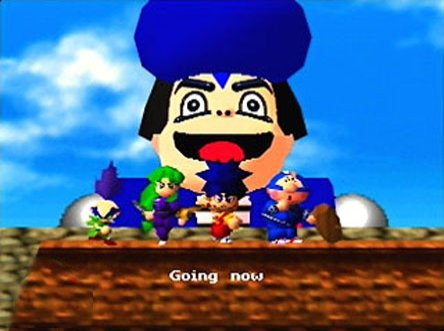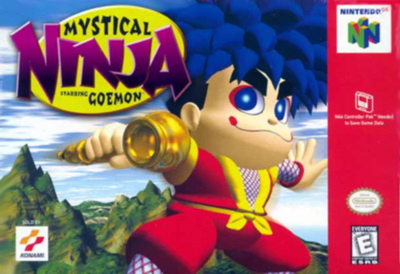
As always, a friendly reminder that this post may contain spoilers
I can’t say for sure when we purchased Mystical Ninja for the N64. All I know is that the memories that followed were always ones of great joy. The crazier part is that all my friends had the game as well, and we basically raced to beat it. I can’t think of a lot of console games that we all owned that we played and enjoyed like that, so right out of the gate, Mystical Ninja has a big place in my heart. It’s also one of those games that my older brother and I had played where we went through it knowing nothing, the kind of game that constantly left our minds utterly confused.
You see, the reason for that confusion is that Mystical Ninja is a Japanese game. It is a VERY Japanese game, I mean so Japanese that it’s unbelievable. Here is the main cast of characters that you can play:

Pictured Above, Left to Right then Top (Sasuke, Yae, Goemon, Ebisumaru, and Impact)
Since it’s a primarily Japanese series that is rooted in Japanese mythology and ancient Japanese culture, I’m really surprised that we got this game (though we did also get The Legend of the Mystical Ninja for SNES). A bunch of the zany humor in it is only funny because it makes no sense. It might have been more humorous to a Japanese player, and for this I congratulate the localization team, especially for being able to have everything make sense (at least in context). Instead of turning me off from it, the wacky characters and situations only made it resonate more with my impressionable mind.
The reason I chose this game for this series of posts is that it has one of my favorite soundtracks of all time. I have no shame in saying that nostalgia plays a big part in that, but hey, give me some credit here. The soundtrack was composed in a team effort by Shigeru Araki, Yusuke Kato, Saiko Miki, and Yasumasa Kitagawa. The shamisen instrument features commonly in the soundtrack, and it is accompanied by various other more contemporary sounds. This was so the game could seem up-to-date while having the classical Japanese feel. The cartridge size was 128 Mb, large enough to accommodate the high quality music and voices that would go into the game. Also, two performers who I want to make a special note of are Hironobu Kageyama and Ichirou Mizuki.
They did the vocals for two of the songs on the soundtrack, which are definitely showing up on the list, and have a singing style that may actually be recognizable to a lot of people. You see, they are the guys who sing the theme songs to classic anime and Tokusatsu shows. Mizuki sang the themes of Tekkaman, some Kamen Rider series, Mazinger, Robot Detective, and many more. One really notable song that Hironobu Kageyama performed was the first theme song to Dragonball Z called HEAD CHA-LA (if you’ve seen DBZ abridged, you’ve probably heard it). These guys are really well known overseas, and although a lot of their work might be unknown to us, their methodology and what made them so famous comes through every time. As much as I’d love to pick every song on the soundtrack, I figure that’d be a little too much, so I’m gonna pick out my most notable ones.
Songs
Theme Song
Hironobu Kageyama brings us the theme song to the game. The point of this theme was to let players know that they were playing a Mystical Ninja game, a game full of adventure and happiness. Indeed, there are few parts in Mystical Ninja that are downright sad. There is drama, yes, but it’s mostly a heroic story with tons of humor built in. Listening to this song makes me think of the game as just another episode of a beloved series, which is probably what they were going for here. You can hear how they made use of that increased cartridge size, allowing the voice to come in loud and clear.
Oedo Castle
Oedo Castle is the first dungeon of the game, and the music of the castle itself starts at 1:12 (everything up until 1:08 is just when you’re running to get into it). A first level theme needs needs to get me into the game. If your game is populated by dungeons, the first one needs to be catchy enough that I get on board with it. Oedo castle has that mix of shamisen and pop style. There’s a really interesting thing about dungeon themes in this game… let’s see if you can figure out what it is. I’ll reveal it when I get to the other castle on the list.
I am Impact
These are my favorite parts of Mystical Ninja and are the sections that I always look forward to the most. If you’ve played the game, you know the song, and you can bet anything that whenever it comes up, I’m singing along. I am Impact is the song that plays as you get into your giant fighting robot, Impact. This song is performed by Ichirou Mizuki, dubbed the “Emperor of Anime Songs”, and for good reason. If you watched any kind of Tokusatsu show (Power Rangers, Ultraman, pretty much any live action series with lots of special effects and giant monsters), this song will resonate with you and get you excited.
In essence, this is pretty much the song that plays when a character goes into their large transforming sequence in any anime ever. It’s just another mechanic used to get the player into the mindset that they are playing an anime instead of just a game. It’s my favorite song on the soundtrack – hands down no question. Somebody get the blue ribbon for the contest that doesn’t exist.
Tsurami
There were hard bosses when I was a kid, and then there was Tsurami. I would only ever barely beat this boss, but his music always helped me. It’s a good boss theme, so it gets your blood pumping, and has that ghostly start. There’s another boss theme that’s the same as this one, but has a different start, so I picked the song for Tsurami because to me he’s the more challenging boss. The songs for the on-foot bosses (Tsurami and Dharmanyo) were always great to listen to, and every list deserves some kind of boss song.
Submarine Castle
For the use of the shamisen, Submarine Castle is one of my favorite songs on the soundtrack. It also does the best job of showing off an interesting feature of the dungeon songs. Every castle (other than the last one) has a theme that evolves as you advance further in. Obviously, it’s not as easy to tell this when you’re not playing, but try listening to Oedo and Submarine Castle take on more forms as it goes on. It makes for very interesting ways to hear the music.
They add more instruments and quicken the pace, but for the most part, people who play won’t notice the changes happening. This is awesome sound design and underscoring used at its fullest to enhance the castle you’re in. The melody keeps an upbeat stride so that you don’t lose your momentum as you progress inwards. It’s just one of the many things about the Mystical Ninja soundtrack that it does so well in comparison to other soundtracks.
Musical Castle
The Musical Castle is the final level of the game, and is broken up into three separate parts. 0:00 – 1:10 is the theme of the beginning and stage-like area, 1:11 – 3:25 is when you’re outside and visiting all the people that were on Kyushu before it got warped into space, so it’s much more calm and 3:30 – 6:59 is the final, actual castle portion of the stage. This is the music playing when you first hit the dungeon after reaching the point of no return, and you’re greeted by an aggressive and showy style of shamisen music. The antagonists want to make the world their stage, so the use of aggressively played traditional music makes sense.
The real fight begins when you upgrade your weapons and step into the final part of the Musical Castle. There is shamisen in there, but the guitar is featured most heavily of all. It’s playing out the situation that is occurring in the game: that Goemon and Co. are so close to reaching the final enemies and saving the world. I like to think that the music doesn’t change in these sections because it’s the final part of the game so progression doesn’t make as much sense. The final music is at the end of your progression, and so is the boss that accompanies it.
Afterthoughts
I have a lot of fond memories with Mystical Ninja: Starring Goemon. It introduced me to Japanese mythology and concepts like kappas enjoying cucumbers and giant kabuki robots. It had the humor, the action, and of course, the great music. I’d say that it would be quite difficult for me to find a song on this soundtrack that I don’t like. It’s all so good, so even if you don’t play the game, you should really listen to the rest of the music as well. I believe we only got one more game after this one called Mystical Ninja: Goemon’s Great Adventure, which went back to the roots of the SNES game.
That will wrap it up for today’s post. Comment below on what music from the soundtrack you really liked that I may or may not have mentioned, or just comment on the article itself. Either way, I’ll see you all tomorrow!
DASH DASH DASH
Bonus Song
Goemon’s Great Adventure – Ryugu Palace
It looks like the sequel games in this series didn’t drop in quality! I haven’t beaten Goemon’s Great Adventure, but I know enough to know that the music is awesome as hell. Listen and enjoy!

